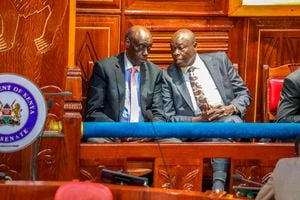Japan-Kenya ties helping to revive the economy

Kenyans living in Tokyo, Japan, welcome President William Ruto and First Lady Rachel on February 7, 2024.
What you need to know:
- Official data show Kenyan exports to Japan recovering from the Covid-19 slump.
- The State Department of Foreign Affairs stands at a pivotal spot in driving these partnerships.
In an opinion article last week, Ngovi Kitau accused the State Department of Foreign Affairs of failed to deliver on its key mandate of managing and communicating the country’s foreign policy.
As a former ambassador to South Korea, Mr Kitau no doubt understands the intricacies involved in managing the diverse expectations of two complex economies coming together at the negotiating table.
He demonstrates that by outlining the three functions of the department and the legislative instruments that spell them out.
Where he veers off tangent is dedicating the rest of his article to needlessly analysing Japanese Prime Minister Fumio Kishida’s speech as if it were the joint communique at the bilateral meeting.
President William Ruto’s visit to Japan marked a turning point in bilateral relations between Tokyo and Nairobi, and the economic gains to our region are well known and documented.
Kenya’s leading partners
It was undergirded by investment pledges and commitments worth Sh45 billion, reaffirming the two countries’ commitments to strengthen diplomatic and trade relations for the benefit of their nations’ citizens.
Japan has been one of Kenya’s leading partners. This relationship has realised significant gains in infrastructure development and technology transfer across sectors.
Official data show Kenyan exports to Japan recovering from the Covid-19 slump, increasing from Sh4.7 billion in 2020 to Sh5.9 billion in 2022.
The value of imports from Japan has been relatively stable, only reducing from Sh99 billion in 2018 to Sh97 billion in 2022.
A major source of tourism earnings, Japanese tourists to Kenya increased by more than a third in 2021-2022, their hotel bed occupancy shooting up to 24,000 in 2022 from 18,600 the previous year.
Besides, agencies such as the Japan International Cooperation Agency (Jica) have a prominent presence in key areas like road and bridge construction, electricity generation and urban modernisation.
Kenya’s manufacturing capacity
The latest raft of investments from Tokyo includes the Sh15 billion Meru Wind Farm Energy project. That will see Meru County host Africa’s first hybrid renewable energy plant.
In another Kenyan first, the Meru County Energy Park will provide up to 80 MW of clean energy using up to 20 wind turbines and over 40,000 solar panels, powering more than 200,000 households. And a Sh8 billion Isiolo Solar Energy project is expected to significantly add to Kenya’s installed capacity of clean energy.
In the past financial year, Japan pledged Sh17.6 billion in infrastructure projects in Mombasa County — like Phase II of the Mombasa Port Area Road Development Project (Sh5 billion), construction of the Mombasa Gate Bridge (Sh9.6 billion) and Dongo Kundu Special Economic Zone (Sh2.5 billion).
Kenya is a geothermal energy generation and expertise leader, courtesy of such partnerships as with Japan.
Both countries have, for instance, committed to boosting Kenya’s manufacturing capacity through local assemblies and technology transfer.
The State Department of Foreign Affairs stands at a pivotal spot in driving these partnerships.
Mr Wahome is the managing director of BlueFocus Africa, a corporate reputation advisory firm. [email protected].





